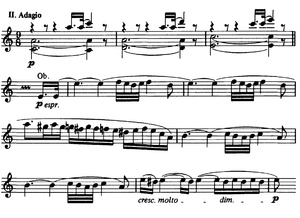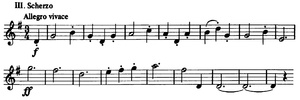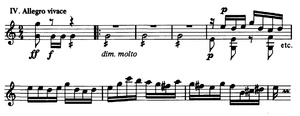Symphony in C major (Bizet)
The symphony in C major is a work by the 17-year-old French composer Georges Bizet (1838–1875), but it was not premiered until 1935.
Origin, premiere and reception
Georges Bizet, at that time a student in the composition class of Jacques Fromental Halévy at the Conservatoire de Paris , began four days after his 17th birthday, on October 29, 1855, with the composition of his C major symphony, which he had already completed before the end of the November completed. It was neither performed nor printed during his lifetime. After Bizet's death, his widow passed the score along with other manuscripts to his friend Reynaldo Hahn . In 1933 he gave the manuscript to the Paris Conservatoire. It was there that Douglas Charles Parker , the first British Bizet biographer, came across the work and made Felix Weingartner aware of it. He brought the symphony to a successful premiere in Basel on February 26, 1935, 80 years after it was composed .
The work went to press in September 1935 by Universal Edition . Numerous recordings, beginning in 1935 under the direction of Walter Goehr , testify to the popularity that the symphony has enjoyed since then .
George Balanchine choreographed a ballet version of Bizet's Symphony in C major , which premiered in 1947.
Bizet's work, identified in the manuscript as “Ière Symphonie”, was followed by at least two - but not further elaborated - approaches of the same genre during his stay in Rome, including the first plans for the symphony “Roma” from 1859, which the composer revised several times and posthumously called the “3ème Suite de Concert ”, but sometimes also as Bizet's“ 2. Symphony ”.
Cast, playing time and characterization
The score requires the following scoring : 2 flutes , 2 oboes , 2 clarinets (in C), 2 bassoons , 4 horns , 2 trumpets , timpani and strings .
The playing time of Georges Bizet's C major symphony is around 30 minutes. It follows the classic four-movement form with the following sentences:
- Allegro vivo
- Andante. adagio
- Allegro vivace
- Final. Allegro vivace
Bizet's C major symphony, an early stroke of genius, can be placed in a row with its balance and successful instrumentation, for example with the 3rd symphony by 18-year-old Franz Schubert or the Midsummer Night's Dream overture by 17-year-old Felix Mendelssohn .
The first symphony in D major by Charles Gounod , composed in 1855 and which Bizet had arranged for two pianos shortly before composing his own work, served as a model . This shows similar styles such as fast string figurations, sequencing development sections and a fugue part in the slow movement that occurs in both works, right through to parallels in thematic formation. Further role models can be found in the Viennese Classic , Mendelssohn and Gioacchino Rossini . Echoes of Schubert, on the other hand, are probably coincidental, as his instrumental work was still completely unknown in Paris at the time.
The first movement follows a conventional sonata form , processes the presented thematic material in an economical way and is clearly based on classical models. In some features, such as the pointed rhythm and articulation, it already shows the character traits of the later Bizet.
The main theme of the slow movement, intoned by the oboe, has an oriental flavor and in turn points to later works, such as the opera Carmen . On the other hand, the fugal middle section of the 2nd movement has a more academic character.
In the Scherzo, the first, fanfare-like theme also provides the material from which the following, musette- like trio section is derived.
The finale again follows the sonata form and, with its opening theme and the march-like transition of the woodwinds, in turn foreshadows later works by the composer.
Individual evidence
- ↑ The Bizet Catalog, Hugh Macdonald, with further information on the autograph etc.
- ^ Wulf Konold (Ed.): Lexicon Orchestermusik Romantik. AH . Piper / Schott, Mainz 1989, ISBN 3-7957-8226-0 , p. 53.
literature
- Winton Dean : Georges Bizet. Life and work . DVA, Stuttgart 1988, ISBN 3-421-06385-0 , pp. 20, 179-187.
- Hans Renner, Klaus Schweizer: Reclam's concert guide for orchestral music . 10th edition. Philipp Reclam jun., Stuttgart 1976, ISBN 3-15-007720-6 , pp. 367-368.
Web links
- Bizet: Symphony in C Major : Sheet Music and Audio Files in the International Music Score Library Project
- Scoring details, score preview, Universal Edition




